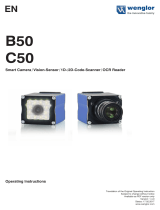
STEP 2: CONNECT POWER CABLES
Connect x2 Camera Cables from Cameras to back of
Scanbox.
Connect DC Power supply to back of Scanner Box.
Press the power button. The LED will turn and stay blue once
the scanner is booted up correctly.
3
4
5
2
STEP 3: DOWNLOAD FLEXSCAN3D
STEP 4: CREATE NEW PROJECT
STEP 5: PLACE SCANNER
Plug in the USB license dongle that comes with the scanner
system into PC. (Can be found in the travel case)
Open FlexScan3D Software. Go to the Scanners tab. Click
New. Select Compact/Carbon type from dropdown menu.
For the rst time using the scanner, place the object at the
default calibration medium stando distance of 700mm
measured from front of rail. Cameras should always be in a
symmetrical distance on rail from eachother.
Change projection pattern to focus from the Scanner
window. If the red crosshairs are aligned with the projection
centre, it can be veried that the object is in perfect focus.
If not, move the object and scanner closer or farther apart to
align them.
For dierent object sizes, the camera positioning and focus
need to be adjusted, and a recalibration is required whenever
any adjustment is made.
Log into Polyga account page and download the latest
version of FlexScan3D Software.
1
1
1
3
2
2
2
4
1
3
2
4
Connect Camera Trigger Cables to back of Scanner Box.
Note: Make sure to line up notches on connector.
!
!
Carbon X is calibrated from the factory but Calibration is
needed whenever cameras are moved. See Step 7 for the
calibration steps.
Leave Z-index Conguration (Depth of eld) at default.
Go to the Project tab. Create a new project and name it
something you can remember.
!Carbon X will not work with FlexScan3D Version 3.5.5.4 or
older.
Connect Active USB Cable from PC to back of Scanner Box.









